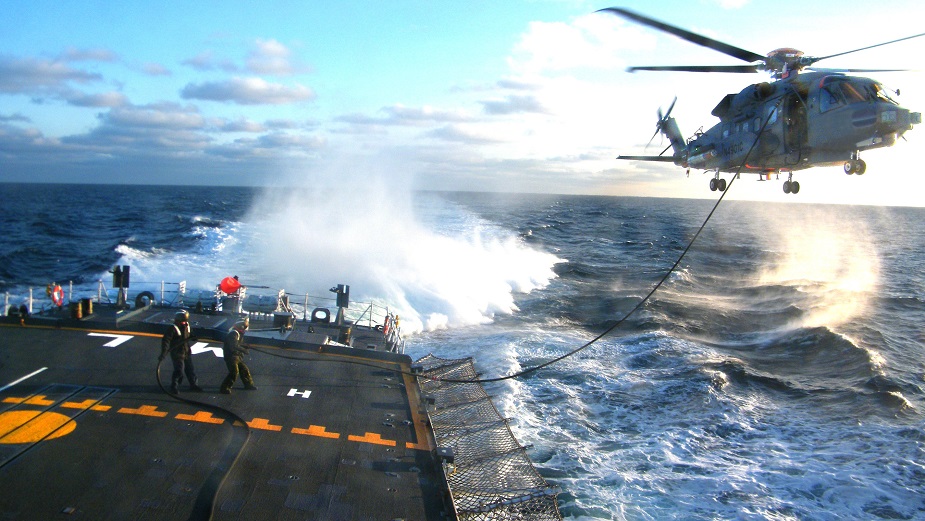AHS International has recognized Canada's Department of National Defence (DND) and Sikorsky, a Lockheed Martin company, for "conducting an extraordinary international effort" to demonstrate flight and shipboard operation of the CH-148 Cyclone maritime helicopter from a Royal Canadian Navy Halifax-class frigate. The award cites successful expansion of the flight envelop to Sea State 6 conditions, where waves reached a height of six meters (20 feet) with winds up to 55 knots (100 km/hour or 63 mph).
 A CH-148 Cyclone helicopter performs a hover in-flight refueling test during sea trials aboard a Royal Canadian Navy Halifax-Class frigate in the North Atlantic. Lockheed Martin picture.
A CH-148 Cyclone helicopter performs a hover in-flight refueling test during sea trials aboard a Royal Canadian Navy Halifax-Class frigate in the North Atlantic. Lockheed Martin picture.
On May 16, 2018, representatives from the Canadian Maritime Helicopter Project (CMHP) Combined Test Force accepted the Leonardo International Fellowship Award during AHS International's annual forum. The award recognizes significant contributions to international vertical flight cooperation.
"The combined industry and government flight test team collaborated fully to demonstrate the CH-148 Cyclone helicopter's anti-submarine and anti-surface warfare missions during some of the roughest winter weather imaginable," said William Falk, Sikorsky CMHP director. "Successful demonstration of strict ship/helicopter capability is required before the Canadian government can deploy this helicopter weapon system."
The CMHP Combined Test Force sailed five times into the waters off Nova Scotia from 2010-2017 during late December to early March when the weather conditions produced the necessary wave heights and winds. In total, the team flew 270 hours and performed approximately 975 landings on the flight decks of HMCS Montréal and HMCS Halifax.
Key among the design features for the Cyclone, Sikorsky engineered:
a retractable probe on the belly of the aircraft to more securely cinch the 29,300-lb. Cyclone to the ship's flight deck in high sea states;
a ground support tool with an articulating arm that, with the Recovery, Assist, Secure and Traverse (RAST) system, allows the deck crew to remotely align the aircraft's nose prior to guiding the helicopter into the hangar.
A combined DND/Sikorsky aircrew also demonstrated utility of the aircraft's full authority fly-by-wire flight controls, which can hold the aircraft in a precise hover during high wind states.
Other tests included main rotor blade and tail pylon fold, hover-in-flight refuel, maintenance operations, torpedo loading, and ship-to-ship replenishment. These operations also were demonstrated at night with and without night vision goggles.
The shipboard tests were part of a 10-year, 2,800-hour flight test program that is expected to conclude in early 2019. The Royal Canadian Air Force will take delivery of the last of its 28 Sikorsky designed and built CH-148 Cyclone aircraft by 2021 to replace the CH-124 Sea King helicopter fleet, which retires this year.
Incorporated in 1943 as the American Helicopter Society, AHS International today continues to bring together industry, academia and government to tackle the toughest challenges in vertical flight technology.










